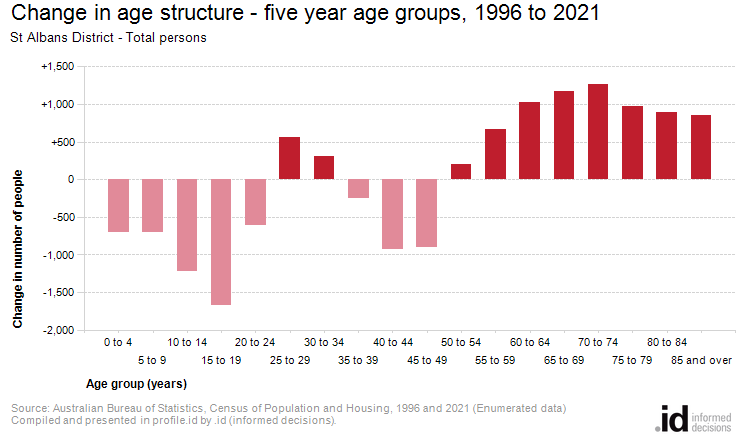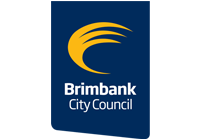St Albans District
Five year age groups
In 2021, the largest age group in St Albans District was 25 to 29 year olds. The group that changed the most since 1996 was 15 to 19 year olds, decreasing by 1,672 people.
The Age Structure of St Albans District provides key insights into the level of demand for age based services and facilities such as child care. It is also an indicator of St Albans District's residential role and function and how it is likely to change in the future.
Five year age groups present a classic age profile of the population. Each age group covers exactly five years, which enables direct comparison between each group.
To get a more complete picture St Albans District's Age Structure should be viewed in conjunction with Household Types and Dwelling Types.
Derived from the Census question:
'What is the person's date of birth or age?'
Total population
| Age structure - Five year age groups | ||||||||
|---|---|---|---|---|---|---|---|---|
| St Albans District - Total persons (Enumerated) | 2021 | 1996 | Change | |||||
| Five year age groups (years) | Number | % | Greater Melbourne % | Number | % | Greater Melbourne % | 1996 to 2021 | |
| 0 to 4 | 2,813 | 5.7 | 5.9 | 3,515 | 7.2 | 6.9 | -702 | 2001 |
| 5 to 9 | 2,875 | 5.8 | 6.3 | 3,574 | 7.4 | 6.9 | -699 | 2002 |
| 10 to 14 | 2,632 | 5.3 | 6.0 | 3,857 | 8.0 | 6.7 | -1,225 | 2003 |
| 15 to 19 | 2,669 | 5.4 | 5.6 | 4,341 | 8.9 | 7.0 | -1,672 | 2004 |
| 20 to 24 | 3,595 | 7.3 | 6.7 | 4,208 | 8.7 | 8.1 | -613 | 2005 |
| 25 to 29 | 4,366 | 8.8 | 7.8 | 3,801 | 7.8 | 8.4 | +565 | 2006 |
| 30 to 34 | 3,996 | 8.1 | 8.3 | 3,686 | 7.6 | 8.3 | +309 | 2007 |
| 35 to 39 | 3,455 | 7.0 | 8.1 | 3,704 | 7.6 | 8.1 | -249 | 2008 |
| 40 to 44 | 2,938 | 5.9 | 6.9 | 3,859 | 8.0 | 7.4 | -922 | 2009 |
| 45 to 49 | 2,791 | 5.6 | 6.5 | 3,687 | 7.6 | 7.1 | -896 | 2010 |
| 50 to 54 | 2,942 | 5.9 | 6.3 | 2,736 | 5.6 | 5.5 | +206 | 2011 |
| 55 to 59 | 2,821 | 5.7 | 5.6 | 2,160 | 4.5 | 4.4 | +660 | 2012 |
| 60 to 64 | 2,750 | 5.6 | 5.1 | 1,726 | 3.6 | 3.7 | +1,023 | 2013 |
| 65 to 69 | 2,647 | 5.4 | 4.3 | 1,476 | 3.0 | 3.5 | +1,170 | 2014 |
| 70 to 74 | 2,371 | 4.8 | 3.8 | 1,106 | 2.3 | 3.1 | +1,264 | 2015 |
| 75 to 79 | 1,592 | 3.2 | 2.8 | 613 | 1.3 | 2.2 | +978 | 2016 |
| 80 to 84 | 1,153 | 2.3 | 2.0 | 260 | 0.5 | 1.5 | +892 | 2017 |
| 85 and over | 1,045 | 2.1 | 2.0 | 190 | 0.4 | 1.2 | +855 | 2018 |
| Total population | 49,451 | 100.0 | 100.0 | 48,507 | 100.0 | 100.0 | +943 | |
Source: Australian Bureau of Statistics, Census of Population and Housing (opens a new window) 1996 and 2021. Compiled and presented by .id (opens a new window)(informed decisions).
(Enumerated data)

Compiled and presented in profile.id by .id (informed decisions).

Compiled and presented in profile.id by .id (informed decisions).
Dominant groups
Analysis of the five year age groups of St Albans District in 2021 compared to Greater Melbourne shows that there was a lower proportion of people in the younger age groups (under 15) and a higher proportion of people in the older age groups (65+).
Overall, 16.8% of the population was aged between 0 and 15, and 17.8% were aged 65 years and over, compared with 18.2% and 14.9% respectively for Greater Melbourne.
The major differences between the age structure of St Albans District and Greater Melbourne were:
- A larger percentage of persons aged 65 to 69 (5.4% compared to 4.3%)
- A larger percentage of persons aged 25 to 29 (8.8% compared to 7.8%)
- A larger percentage of persons aged 70 to 74 (4.8% compared to 3.8%)
- A smaller percentage of persons aged 35 to 39 (7.0% compared to 8.1%)
Emerging groups
From 1996 to 2021, St Albans District's population increased by 944 people (1.9%). This represents an average annual population change of 0.08% per year over the period.
The largest changes in age structure in this area between 1996 and 2021 were in the age groups:
- 15 to 19 (-1,672 persons)
- 70 to 74 (+1,264 persons)
- 10 to 14 (-1,225 persons)
- 65 to 69 (+1,170 persons)
